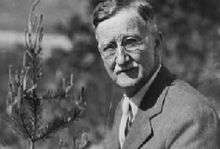Charles C. Deam
| Charles C. Deam | |
|---|---|
 Charles C. Deam | |
| Born |
August 30, 1865 Wells County, Indiana |
| Died |
May 29, 1953 Bluffton, Indiana |
| Occupation | pharmacist, small business owner surveyor, botanist, American conservationist, forester |
| Spouse(s) | Stella Mullins |
| Children | Roberta Ortenburger |
Charles Clemon Deam was the first state forester of Indiana. He was born on August 30, 1865[1] on the family farm near Bluffton in Wells County, Indiana.[2] Deam grew up on the family farm, where his father taught him about the plants on the farm before attending DePauw University for two years before leaving due to the cost of tuition.[2] He was an avid amateur botanist who worked in a pharmacy, which he had partial ownership in until his death.[3] His work as a clerk in a pharmacy led him to botany in an indirect way. Long work days of up to 14 hours caused stress. His doctor recommended that he take walks to reduce the stress.[1] It was on those walks that Deam indulged his interest in botany, a hobby that would eventually lead him to a career in forestry for the state of Indiana.[2] Deam's work as a forester has been honored by both the United States government and the state of Indiana. Two protected areas, Charles C. Deam Wilderness, part of the Hoosier National Forest and Deam Lake State Recreation Area an Indiana state park are named for him.[4][5][6]
Deam collected many different plants on his walks and established an herbarium. His collection of 78,000 plants[6] is now housed at Indiana University in Bloomington and is one of the largest private collections of plants in the state.[2] Deam became a member of the Academy of Sciences in Indiana. Deam's work in botany caught the attention of Indiana Governor Thomas R. Marshall, who established the Indiana State Board of Forestry in 1909.[2] Deam was appointed state forester by Marshall soon after. As part of his job, he moved to Clark State Forest in Clark County. Deam held the position until 1913 when Samuel M. Ralston was elected governor. Charles Deam was reappointed state forester in 1917 with the election of James P. Goodrich and held the job until 1928.[6]
Deam's work as state forester was notable for several reasons. While working at Clark State Forest, he actively sought ways to reclaim the forest on land that was cleared for farming and timber. Deam convinced the state to purchase an additional 2,000 acres (810 ha) to add the state forest lands in Clark County. Deam studied the environmental needs of the second growth forests. He noted the history of the forests as they here affected by settlement and farming in southern Indiana. Deam wrote,
| “ | "The extreme fertility of the soil attracted the relatives and friends of the first settlers which displaced the Indians until 1832…. [S]ettlement rapidly followed and magnificent forest areas were cut and burned to obtain more arable land…. People soon learned that they could enter or buy a tract of land, sell off enough timber to erect a house and barn and to pay for the land. Saw mills were soon built every few miles along the railroads. It was soon learned that Indiana white oak, black walnut, yellow poplar, etc., were among the best of their kind in the world."[2] | ” |
He wrote about the effects of tree loss on soil erosion. Most of the forests in Indiana had been cut down to make room for farms or strictly for lumbering purposes. The loss of trees and their roots led to increased erosion.[2]
Deam worked to help farmers and lumbermen by encouraging sustainable use practices far ahead of its time. He worked to have state laws changed so that farmers would not be taxed for the land that they owned that they did not farm.[2] Previously farmers were taxed for every acre of land that they owned. This motivated them to use every acre of land for farming and led to the mass clearing of their land. The Forest Classification Act of 1921 allowed farmers to leave trees alone on land that was not taxable. Within 25 years, 2,000 acres (810 ha) of woods had been preserved on farmers' lands in Indiana. Deam's legislation served as a model for other states and thereby helped preserve forests in other states.[2] Deam retired as state forester in 1928 but remained with the forestry department as a researcher for many years. He walked through all 1016 townships in Indiana, discovered 25 new plants and has 48 plants named for him.[6] Charles Deam died on May 29, 1953.[6]
Books
Charles Deam wrote four books about plants in Indiana.[2][6]
- Trees of Indiana - 1911
- Shrubs of Indiana - 1924
- Grasses of Indiana - 1929
- Flora of Indiana - 1940
References
- 1 2 Carman, Sam. "Charles Deam: In His own Words". University of Southern Indiana. Retrieved September 29, 2010.
- 1 2 3 4 5 6 7 8 9 10 "Our Land, Our Literature: Charles C. Deam (1865-1953)". Ball State University. Retrieved September 28, 2010.
- ↑ "Charles C. Deam obituary". New York Times. May 31, 1953.
- ↑ "History of the Deam Wilderness Area". United States Forest Service. Retrieved September 29, 2010.
- ↑ "Deam Lake State Recreation Area". Indiana Department of Natural Resources. Retrieved September 28, 2010.
- 1 2 3 4 5 6 "Charles Clemon Deam (1865-1953)" (pdf). Indiana Department of Natural Resources. Retrieved September 29, 2010.
- ↑ IPNI. Deam.
- Primary Sources
- Charles C. Deam papers, 1881-1983, bulk 1900-1953 at the Indiana University Archives.
- Deam Wilderness manuscripts, 1963-1988 at the Indiana University Lilly Library.